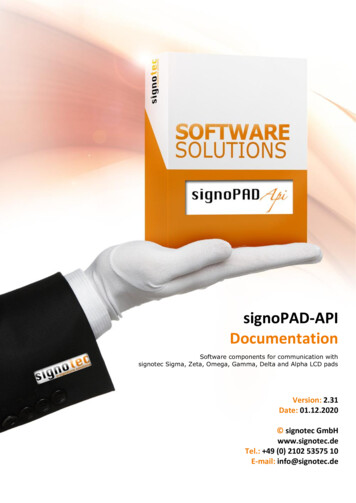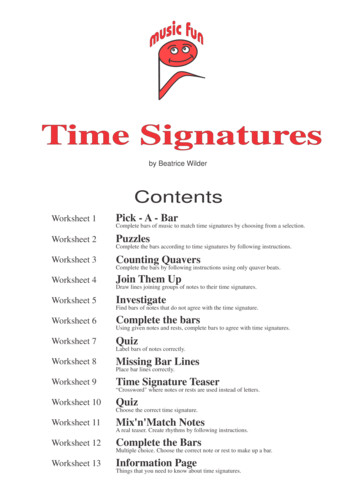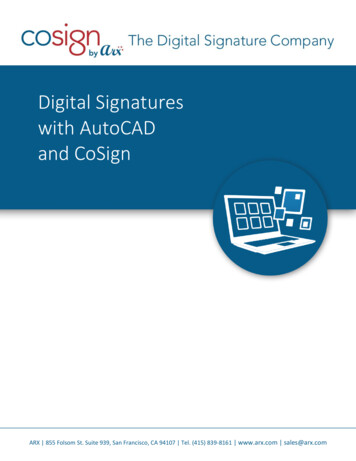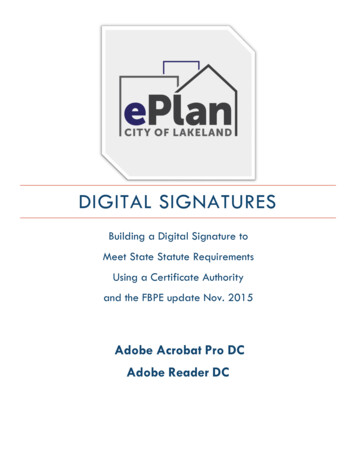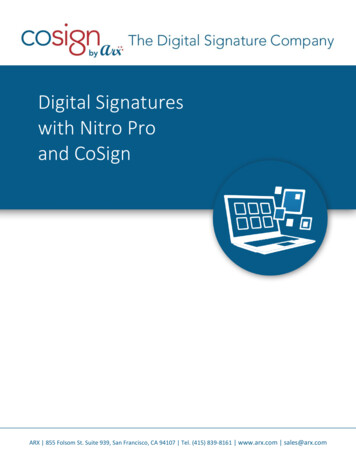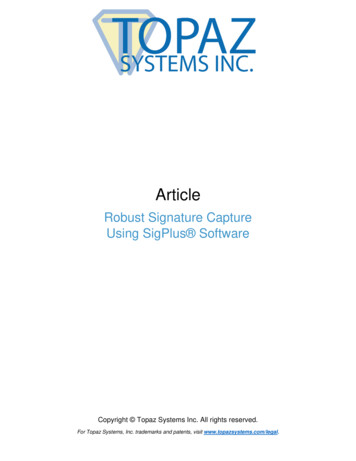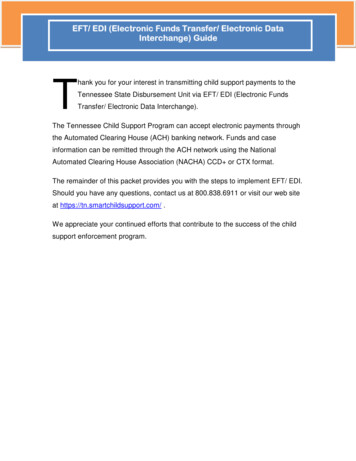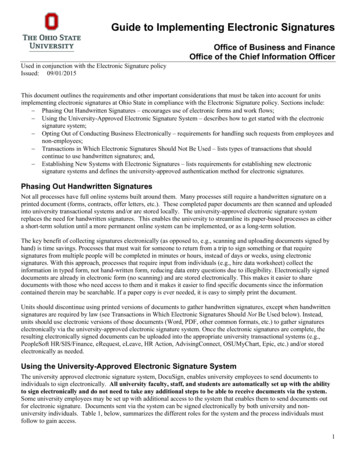
Transcription
Guide to Implementing Electronic SignaturesUsed in conjunction with the Electronic Signature policyIssued: 09/01/2015Office of Business and FinanceOffice of the Chief Information OfficerThis document outlines the requirements and other important considerations that must be taken into account for unitsimplementing electronic signatures at Ohio State in compliance with the Electronic Signature policy. Sections include: Phasing Out Handwritten Signatures – encourages use of electronic forms and work flows; Using the University-Approved Electronic Signature System – describes how to get started with the electronicsignature system; Opting Out of Conducting Business Electronically – requirements for handling such requests from employees andnon-employees; Transactions in Which Electronic Signatures Should Not Be Used – lists types of transactions that shouldcontinue to use handwritten signatures; and, Establishing New Systems with Electronic Signatures – lists requirements for establishing new electronicsignature systems and defines the university-approved authentication method for electronic signatures.Phasing Out Handwritten SignaturesNot all processes have full online systems built around them. Many processes still require a handwritten signature on aprinted document (forms, contracts, offer letters, etc.). These completed paper documents are then scanned and uploadedinto university transactional systems and/or are stored locally. The university-approved electronic signature systemreplaces the need for handwritten signatures. This enables the university to streamline its paper-based processes as eithera short-term solution until a more permanent online system can be implemented, or as a long-term solution.The key benefit of collecting signatures electronically (as opposed to, e.g., scanning and uploading documents signed byhand) is time savings. Processes that must wait for someone to return from a trip to sign something or that requiresignatures from multiple people will be completed in minutes or hours, instead of days or weeks, using electronicsignatures. With this approach, processes that require input from individuals (e.g., hire data worksheet) collect theinformation in typed form, not hand-written form, reducing data entry questions due to illegibility. Electronically signeddocuments are already in electronic form (no scanning) and are stored electronically. This makes it easier to sharedocuments with those who need access to them and it makes it easier to find specific documents since the informationcontained therein may be searchable. If a paper copy is ever needed, it is easy to simply print the document.Units should discontinue using printed versions of documents to gather handwritten signatures, except when handwrittensignatures are required by law (see Transactions in Which Electronic Signatures Should Not Be Used below). Instead,units should use electronic versions of those documents (Word, PDF, other common formats, etc.) to gather signatureselectronically via the university-approved electronic signature system. Once the electronic signatures are complete, theresulting electronically signed documents can be uploaded into the appropriate university transactional systems (e.g.,PeopleSoft HR/SIS/Finance, eRequest, eLeave, HR Action, AdvisingConnect, OSUMyChart, Epic, etc.) and/or storedelectronically as needed.Using the University-Approved Electronic Signature SystemThe university approved electronic signature system, DocuSign, enables university employees to send documents toindividuals to sign electronically. All university faculty, staff, and students are automatically set up with the abilityto sign electronically and do not need to take any additional steps to be able to receive documents via the system.Some university employees may be set up with additional access to the system that enables them to send documents outfor electronic signature. Documents sent via the system can be signed electronically by both university and nonuniversity individuals. Table 1, below, summarizes the different roles for the system and the process individuals mustfollow to gain access.1
Guide to Implementing Electronic SignaturesUsed in conjunction with the Electronic Signature policyIssued: 09/01/2015Table 1: Summary of System Roles and ProcessesRoleSignerAbilitiesSign documents onlyOffice of Business and FinanceOffice of the Chief Information OfficerRequest and Approval ProcessNo request is needed.TrainingRequired?NoUniversity individuals are automatically set up as signers throughthe university identity management system and use their name.nand password to log in and sign documents.Non-university individuals do not need a login/password to sign adocument sent to them by an Ohio State employee; however, theymay be required to enter a code sent via SMS/Text message orother method before they are able to sign.SenderWhat a signer can do plus senddocuments using predefinedforms and templates onlyUniversity Employee completes Institutional Data training,eSignature Overview, and eSignature Sender training. Employeesubmits a request via the DocuSign Request Form inServiceNow. Access Management confirms training is complete.Access Management sends request for approval. Senior FiscalOfficer approves. Access management grants access and informsemployee.YesAuthorWhat a sender can do plus sendcustom/ad hoc documents;create and share predefinedforms and templates withsendersUniversity Employee completes Institutional Data training,eSignature Overview, eSignature Sender, and eSignature Authortraining. Employee submits a request via the DocuSign RequestForm in ServiceNow. Access Management confirms training iscomplete. Access Management sends request for approval. SeniorFiscal Officer approves. Access management grants access andinforms employee.YesAdministratorManage the DocuSign systemand/or integrate DocuSign withother systems via API (OCIOonly)OCIO employees responsible for managing the DocuSign systemand/or for integrating DocuSign with other systems via its APIrequest administrator access directly from the Deputy CIO whoapproves. OCIO employees must complete both Sender andAuthor training plus administrative and, if applicable, APItraining before access will be granted.YesRequesting AssistanceSigners needing technical assistance signing a document electronically may contact 8-HELP (8help@osu.edu), or contactthe unit who sent the document to them originally. Senders and Authors needing assistance should contact 8-HELP whowill immediately route their requests to the OCIO and B&F support teams.Security and Additional ControlsWhen used as directed, the university-approved system provides reasonable assurance (1) of the authenticity of electronicsignatures, (2) that the signatures will not be rescinded (the signer cannot make a legitimate or supportable claim they didnot sign it), and (3) of the integrity of the electronically signed records. The proper use of this system also mitigates risksin cases when the electronic record to be signed contains internal, private, or restricted data as defined by the InstitutionalData policy.2
Guide to Implementing Electronic SignaturesUsed in conjunction with the Electronic Signature policyIssued: 09/01/2015Office of Business and FinanceOffice of the Chief Information OfficerSome additional controls (e.g. a code sent via SMS/Text message in addition to the signature) are required for certaintypes of documents and/or certain signature processes. These controls are addressed in detail as part of the ElectronicSignature Sender and Author training. Signers needing technical assistance with these should contact 8-HELP or the unitthat sent the document originally.Table 2: Summary of Two-Factor Authentication RequirementsShib loginOSU email accountAll data exceptrestrictedRestrictedTwo factorauthentication requiredNoShib loginNoThe author is requiredto use the maskingcriteria and workflowthe document such thatthe input of restricteddata is last in theworkflow whenpossible.Non-OSU frequentuser (e.g. vendors)All data exceptrestrictedDocuSign loginNoAccount needsrequested throughOCIONon-OSU frequentuserRestrictedDocuSign loginYesAccount needsrequested throughOCIONon-OSUinfrequent user(e.g. new hire)All dataN/AYesRecipientOSU email accountType of DataLog-in RequiredOther RequirementsRecords RetentionOnce a document is complete, the unit must retain the resulting records in accordance with the university RecordsRetention Schedule, other university policies (e.g. Personnel Records, Travel, Procurement, etc.) and the InformationSecurity Standards.Opting Out of Conducting Business ElectronicallyAs university processes are converted from handwritten signatures to the university-approved electronic signature system,employees, including student employees, acting within the scope of their employment, are expected to use it and may notopt out of conducting a transaction electronically. However, if an employee needs an ADA accommodation, handwrittensignatures or other approaches recommended by the university ADA coordinator should be used.3
Guide to Implementing Electronic SignaturesUsed in conjunction with the Electronic Signature policyIssued: 09/01/2015Office of Business and FinanceOffice of the Chief Information OfficerIndividuals and entities, excluding employees acting within the scope of their employment, may opt out of conducting atransaction electronically by providing written notice of the decision to opt out of conducting business with the universityelectronically per transaction. The written notice must be directed to the university employee responsible for the businessrelationship with the party. In such cases, handwritten signatures or other approaches recommended by the universityADA coordinator should be used. The notice to opt out should be retained with the record that was signed. Upon receiptof such notice, the university may reassess its interest in contracting with the party choosing to opt out, and retains theright to cancel the pending transaction, unless otherwise obligated by law or agreement.Best practices on how to process requests to opt out are included in the Electronic Signature Sender training. Bestpractices on designing ADA accessible electronic signature forms and templates are included in the Electronic SignatureAuthor training.Transactions in Which Electronic Signatures Should Not Be UsedElectronic signatures should not be used for the following types of transactions (use a handwritten signature): Wills, codicils and testamentary trusts Commercial paper, which includes paper checks and promissory notes (ORC §1303; UCC Article 3) Documents of title, for example a property deed, automotive title or bill of lading (ORC §1307; UCC Article 7) Documents relating to securities, for example a stock certificate (ORC §1308; UCC Article 8) Ohio Public Employees Retirement System formsThe above exceptions do not include transactions involving the sale of goods or services or leases (see ORC §§ 1302,1310; UCC §§ 2, 2A), for which electronic signatures may be used.The university-approved electronic signature system may not be used to collect credit card numbers.Establishing New Systems with Electronic SignaturesIf a unit wishes to implement a new system with a different method of gathering electronic signatures, or seek to use anexisting or the university-approved electronic signature system with a non-standard configuration, it must apply forapproval by sending a request to 8help@osu.edu. The Business and Finance Senior Director for Shared Services and theDeputy CIO of the Office of the CIO will evaluate the request and either approve or deny it using the criteria below. Tobe approved, the new system must:1. Employ a university-approved authentication method at the time of signature (see University-ApprovedAuthentication Method for Electronic Signatures section below);2. Meet Information Security Standards for electronic records that contain institutional data classified as internal,private or restricted (see Information Security Framework, ocio.osu.edu/itsecurity/framework);3. Use separation of duty and other controls to mitigate risks;4. Employ the access, monitoring, maintenance, security, and other controls to provide reasonable assurance of theauthenticity of electronic signatures, that the signatures will not be rescinded, and the integrity of theelectronically signed records.4
Guide to Implementing Electronic SignaturesUsed in conjunction with the Electronic Signature policyIssued: 09/01/2015Office of Business and FinanceOffice of the Chief Information OfficerUniversity-Approved Authentication Method for Electronic SignaturesAn electronic signature that does not employ a university-approved authentication method at the time of signature may notbe binding on the university and because of this, units must use a university-approved authentication method. Auniversity-approved authentication method meets all of the requirements outlined in Table 2. The university-approvedelectronic signature system meets all of these requirements.Table 3: Requirements for University-Approved Authentication Method for Electronic SignaturesRequirementAuthenticityDescriptionThe person signing is whothey say they are.Method/SystemThe system must require authentication before enabling the signer to signelectronically. For university constituents, this authentication will happenwith a user’s university name.n credentials via:ShibbolethOther AD/LDAP system if the signer’s user account is automaticallysynchronized with Ohio State’s Identity Management SystemSigning a PDF file using the “Sign” option in Adobe Reader does not meetthis requirement, nor does just typing one’s name or drawing one’s signature. NonrepudiationThe signer must take anaffirmative action of somekind to sign it. The signercannot make a legitimate orsupportable claim they didnot sign it.Two-factor authentication (a login/password and an additional code given tothe signer by some other means) is required in cases when the signature is ona record that contains private or restricted data or carries material risk.Two-factor authentication also mitigates the risks of: a) a record to be signedbeing forwarded from the recipient to another individual who could sign as ifthey were the original recipient, or b) the email account to which a signaturerequest is sent being compromised.IntegrityIt is possible to tell if acompleted electronicsignature has been falsifiedor tampered with.Workflow systems (e.g., eRequest) are secured to ISS standards so thatcompleted signatures cannot be reversed or tampered with. Systems thatproduce certificates of signing must make those certificates tamper evident(e.g., DocuSign’s digitally sealed certificate).StatutoryRequirement ORC§1306.07Electronic records beingcapable of retention byrecipient at time of receipt.When the signing is complete, the recipient must be capable of retaining theelectronic record in electronic or print form. With DocuSign, this isaccomplished by receipt of a completed PDF once the signing is complete.StatutoryRequirement ORC§1306.04 andORC §1306.16In some cases, it is possibleto opt out of signingelectronically for a particulartransaction.Individuals and entities, excluding employees acting within the scope of theiremployment, may choose to opt out of conducting a transaction electronicallyby providing written notice of a request to opt out of conducting businesswith the university electronically. The written notice must be directed to theuniversity employee responsible for the business relationship with the party.5
other systems via API (OCIO only) OCIO employees responsible for managing the DocuSign system and/or for integrating DocuSign with other systems via its API request administrator access directly from the Deputy CIO who approves. OCIO employees must complete both Sender and Author training plu

